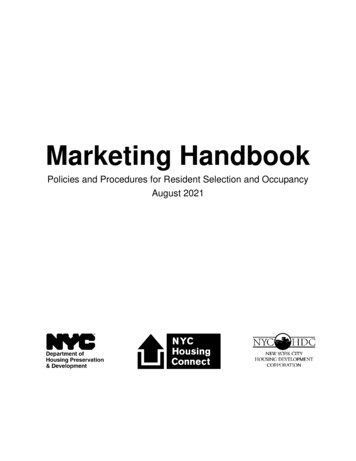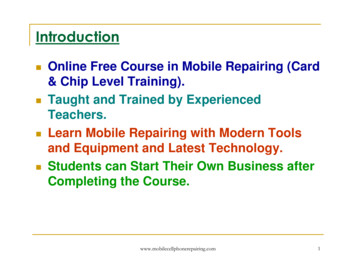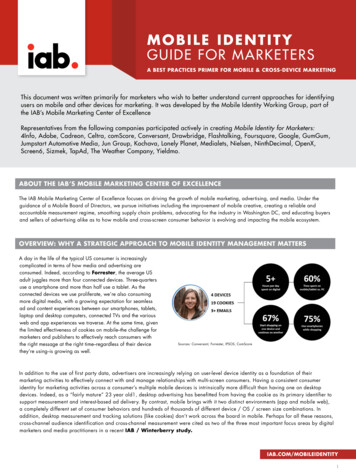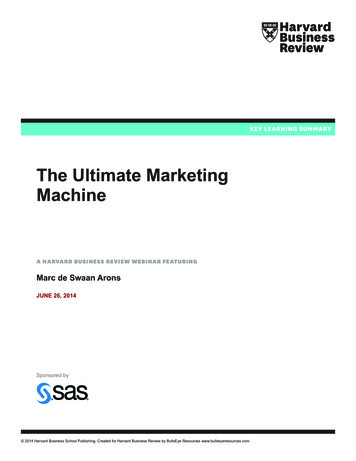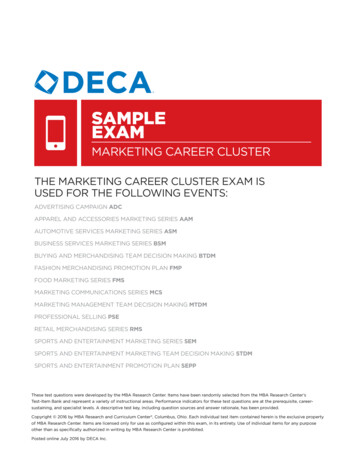
Transcription
1CHAPTERThe Basics andthe Big PictureNo matter how mobile advertising messages are delivered, ourresearch shows that consumers demand that if a company isgoing to invade their personal space with advertising, it betterbe for something of interest to them. Personalization is hypercritical.—Judith Ricker, division president, Harris InteractiveWhat Is Mobile Marketing?Businesses and their brands can reap big rewards from mobile marketingunder the right circumstances. When mobile marketing is done right, youcan reach your customers via mobile with a message they actually want tohear but might not even know it yet. And the real kicker is that your customers will reach out to you for the message.But perhaps I’m getting ahead of myself. First, I should rule out whatmobile marketing is not. Contrary to what many consumers dread (andwhat shady opportunists fantasize about), mobile marketing is not a barrage of unwanted text messages sent via cell phone to someone who maynot want, need, or have any connection with the business sending the messages. That’s just spam.The Mobile Marketing Association defines mobile marketing as: “A set ofpractices that enables organizations to communicate and engage withtheir audience in an interactive and relevant manner through any mobiledevice or network.”My definition of mobile marketing is slightly different: “Mobile marketing is how businesses communicate with consumers on their mobile3
4 The Mobile Marketing Handbookdevices, with their explicit permission, at the right time, at the right placewhile providing relevant value.”Based on either definition, smart mobile marketing isn’t randomlymarketing to people who may or may not be interested in receiving a message. Instead, smart mobile marketing is all about reaching your customers or being reached by them in a way that adds value to their day.You’ve undoubtedly noticed that a core component of my definitioninvolves permission. Mobile marketing will never work well as an invasivemarketing method, and it shouldn’t be undertaken as such under any circumstances. It’s likely to backfire every time. When mobile is used as amarketing tool, the end user must provide explicit permission for thecommunication to happen or it will fail. Any mobile outreach that is sentwithout permission not only impacts the business that is doing it, but italso casts a negative light on the entire industry. (Clearly, this does noteliminate mobile web advertising because anyone who goes online, evenwith a mobile device, naturally assumes that advertising will be interwoven with content somewhere.)Mobile Devices DefinedMobile devices can be any type of cell phone, from basic featurephones to more elaborate smartphones such as iPhones, Androidpowered phones, and BlackBerries. Other devices such as iPads orother tablets, ereaders (Kindle), or PDAs (personal digital assistants) are also options. Even gaming units such as Sony’s handheldgame device PSPs (PlayStation Portables) can be considered mobiledevices because they can access the internet through Wi-Fi and areoften used remotely. For the most part in this book, we will be discussing marketing strategies to reach consumers through their cellphones, but remember, there are many ways to market to consumers via mobile. For your reference, when the phrase “cellphone” is used, I am referring specifically to cell phones and notmobile devices universally. When I use the term “mobile devices,”I’m referring to cell phones and other devices as well.With mobile, a business can interact with customers at any time but onlyif those customers agree to receive a message. Customers can pick up theircell phones to request a text message when they’re out or even at home
The Basics and the Big Picture5watching TV or reading a magazine. Customers can also search on theirmobile devices to find your business’s mobile website. They can also callyour business spontaneously wherever they are. Customers can use theirphones to track where they are and use that data to request informationand coupons from nearby businesses. Under the right circumstances,mobile marketing is likely to be so deeply interwoven into people’s dailylives that they won’t be able to imagine life without it.While consumers have always been able to respond directly to advertising, the process has never been so fluid or so immediate as it is withmobile. The majority of those who use mobile devices have the devicewith them at all times, even while they’re driving, walking down the street,shopping, or even sleeping. Most people will even return home to pick uptheir device if they leave it there. While some people only have a mobiledevice “for emergencies” or one that they “never turn on,” most peoplehave their phones with them and ready to use at all times. Because ofmobile, your customers can and will choose to interact with you at anygiven moment. The key to a successful mobile marketing campaign ismaking your customers want to interact with you. That’s what this book isall about. If you can create a mobile marketing campaign that makes people want to interact with your business, then you will be well on the roadto success.Many marketers mistakenly regard the mobile marketing environmentas a smaller version of the internet or television, but that isn’t the case.Mobile is more than its own unique marketing channel; it is a unique massmedium. As with print, audio recording, radio, cinema, TV, and the internet that came before it, mobile has its own characteristics that make it partof mass media. Even as the newest service for consumers, it is the mostwidespread worldwide, it is the most personal (giving it the ability toclosely target individuals and not general demographics), and it is alwayson with a built-in payment mechanism. But mobile is unlike the internetbecause people interact with the mobile web differently, using a muchsmaller interface than on a full-size computer. It also isn’t similar to television because its content (and your marketing) is consumed by one individual at a time. Individuals search for and find specific information; theydon’t browse on mobile. And the big difference is that people are usually onthe go when they are using mobile and in a “mobile mindset,” whichmeans that they are either in a hurry (need information quickly) or arebored (using the device for entertainment). Either way, they are usingmobile purposefully and are not in the same frame of mind as they arewhen using their desktop browsers. Mobile users are often in a distractionfilled environment, so marketers must be aware of the consumers’ mobile
6 The Mobile Marketing Handbookmindset when creating campaigns. The better aligned your campaign iswith what your customers want and where they are, the more successfulyour initiatives will be.Marketers also tend to underutilize mobile. Your complete, full-size website can be rendered reasonably well on most mobile devices by miniaturizing it, but is that really what your customers want? Some marketers seemobile as the ultimate brand-awareness tool. And while you can use mobilemarketing for branding, it is not the most comprehensive use for it. That’scomparable to buying a Ferrari and only driving it 20 mph to church once aweek. Its potential is wasted. This book can help you tap into mobile’s fullpotential as a marketing tool.How SmartphonesImpact Mobile MarketingThe release of the iPhone in 2007 had a huge impact on mobilemarketing. This powerful mobile device and the brilliant marketing behind it catapulted mobile use and mobile marketing into theforefront of marketing strategies in North America. Of course,there are now a multitude of smartphones (Android phones,BlackBerries, and others) that continue to impact mobile marketing. According to a May 2011 survey of U.S. consumers by Nielsen,55 percent of new phones purchased are smartphones. While it willtake awhile for feature phones to become extinct worldwide, itwill happen.This rapid adoption of smartphones is a factor in how quicklymobile marketing is being accepted. Since today’s mobile deviceshave more functionality, consumers are doing more with them andconnecting with businesses in more interactive ways. Consumersare expecting more from businesses as well. If they can use theirphones in the process, they want to try it, from mobile apps andmobile websites to the ability to pay for products and services. Nodoubt about it, the more powerful the devices become, the morebusinesses must implement mobile marketing.
The Basics and the Big Picture7How Big Is the Mobile Market?The mobile marketplace is big and getting bigger. There are more than 5 billion active cell phone subscriptions worldwide, which accounts for 73 percent of the world’s population. When you consider that this mobileadoption rate includes the very young and the very old who are not typicalcell phone users, this statistic is truly amazing. Even more astonishing is thenews that there are more than 60 countries with more than 100 percentpenetration rate (more than one device per person), according toTomiAhonen Consulting.On his blog titled Communities Dominate Brands (communities-dominate.blogs.com), Tomi Ahonen writes, “UAE (United Arab Emirates) became thefirst country with 200 percent penetration rate already. Italy, Israel, HongKong, Russia are at 150% and climbing. Europe is past 125%. The USA willapproach but probably not yet pass 100% in 2010. It is now racing withVietnam, Morocco, Mexico and Dominican Republic for this ‘honor.’Canada and Japan are holding the tail end for mobile phone penetrationlevel among industrialized countries. Japan will pass 90% in 2010, Canadawill approach that level. Meanwhile Africa will pass 50% mobile phonepenetration level this year [2010].”In comparison, some countries have a much lower internet usage rate.According to InternetWorldStats.com, only 10.9 percent of the Africanpopulation uses the internet. Europe has a 58.4 percent rate of internetuse, and Asia has 21.5 percent, a surprising contrast to its high mobile use.The bottom line is that mobile is used much more than the internet on aglobal scale.It is interesting to note that North America is still lagging behind muchof Asia and Europe in adopting mobile. This is useful because we can lookat these mobile leaders for trends in the mobile space. Interestingly, theexact opposite happened with the internet in the late 1990s because NorthAmerica was well ahead of the curve in adopting internet technology. Still,the North American internet adoption rate is lower than mobile at just 77.4percent. Mobile is used more frequently than the internet even where internet usage rates are the highest.Clearly, mobile users represent a huge market. The next time you are ina public place, look around and see how many people are using cell phonesor other mobile devices. Many people around you will be using their mobiledevices to make calls, search online, send text messages, check email,adjust their calendars, take pictures, or listen to music. If the people you seeare not actively using a phone, they probably have one strapped to theirbelt, tucked in their purse, or gripped in their hand. Compare this to the
8 The Mobile Marketing Handbooknumber of people who are reading or carrying a newspaper or magazine, orlistening to the radio or watching television. Mobile is the only mass mediathat offers this level of continuous interconnectivity to individuals in theirdaily lives.But here’s one word of caution: Even if huge numbers of people havemobile devices, it does not mean that they are waiting for marketing campaigns to be delivered to them on this highly personal device. It simplymeans that there is an opportunity for you to reach your customers moreeasily and more personally than ever before. Likewise, it means your customers have a way to reach you more easily than ever before too. They havea way to connect to your business and with each other directly or indirectlyat all times. You just need to give them the opportunity to engage with yourbusiness via mobile, and it may be easier than you think. These devices arein more people’s hands (literally) than any other mass media for those whowant to find local resources, and your business may be one of thoseresources.According to IDC’s Worldwide Digital Marketplace Model and Forecast,mobile web users are growing rapidly: There were 450 million mobile webusers in 2009, a figure that will exceed 1 billion by 2013. Mobile web usersare actively searching for information about something in their immediatevicinity. According to Cindy Krum, author of Mobile Marketing: FindingYour Customers No Matter Where They Are, mobile searchers are “ready tospend money and just need to know where to spend it.”As impressive as the mobile web statistics are, they pale in comparisonto SMS (text messaging) use. More than 4.2 billion people use SMS and collectively sent 8 trillion text messages in 2011 around the world. You maythink text messaging is only for young people, or you may know people whoclaim they have no intention of learning how to text. However, a September2011 study by Pew Research Center finds nearly three-quarters (73 percent)of American cell phone owners are texting, and nearly one-third (31 percent) prefer texting to talking.In addition to the sheer number of consumers who have mobile accessand actively use it, advertisers are tapping into the growing investment inmobile marketing. Mobile advertising revenue grew from 3.1 billion to 5.9billion in 2009, according to Tomi Ahonen. This figure represents an impressive 85 percent growth rate in a troubled year for the global economy whenadvertising budgets were slashed. At this same time, as nondigital advertisingbudgets were sliced and even internet advertising was flat for the year, mobilegrew by an impressive 85 percent.
The Basics and the Big Picture9Opportunities in Mobile MarketingIf you don’t use your mobile device all the time and can’t see how businessescan easily engage you via mobile, you may be wondering how viable this marketing strategy actually is. Maybe you have been charged with launching amobile campaign and justifying the return on investment (ROI) for the marketing budget allocated for mobile. Or perhaps you realize the full potentialof mobile marketing, as I did on the night of May 23, 2007, when the thoughtof the future of mobile marketing literally woke me up in the middle of thenight. That’s when I decided to start my mobile marketing business. In anycase, you should be aware of the growing opportunities in mobile marketing.Local BusinessesLocal businesses, such as restaurants, spas, salons, night clubs, and retailstores, hold the best opportunities for mobile marketing. This powerful toolcan be used to attract new customers and increase the number of purchases from your current customers. The time is right to mobilize yourbusiness and consider marketing with mobile proactively.Marketing ProfessionalsHaving the ability to strategize and implement a dynamic mobile marketing campaign based on smart marketing principles is a unique skill set tohave. Learning what you need to succeed in mobile marketing is potentiallya huge opportunity for your career.AgenciesIf your clients haven’t asked you to implement mobile campaigns for themalready, they will be asking soon. Your biggest opportunity is being able tointegrate mobile with the rest of the marketing efforts you are doing forthem. Mobile can be a sizable addition to your revenue stream, especially ifyou use a vendor’s private label and bill your clients at retail prices formobile campaigns while you pay wholesale rates to the vendor.Mobile Marketing EntrepreneursAs reported by Entrepreneur.com, “Results from Challenger, Gray &Christmas’s job market index revealed that 8.7 percent of job seekers gainedemployment by starting their own businesses in second quarter 2009, way
10 The Mobile Marketing Handbookup from the record low of 2.7 percent during the last quarter of 2008.” If youwant to start a mobile marketing business, your timing is perfect. The aforementioned local businesses are your ideal target market. Be sure to readmore about this in the Appendix, “How to Start a Mobile MarketingBusiness.”Why You Need to Take Action Now,Even If You’re Not ReadyYou may not think you are ready to launch a mobile marketing campaign,but that is not actually relevant. Your customers are already accessing yourwebsite via their mobile phone (or trying to, anyway). Your customers arelikely to be reading your email messages on their phones; they are usingmobile to interact on their social media networks and may stumble uponyour company’s name or website on their mobile devices. The fact is thatwhether you are proactively reaching out with mobile marketing or not,your business is already interacting with customers in the mobile environment. If you are not paying attention to this, your business may be failing atmobile marketing already by simply ignoring it.Being one of the first in your industry or your neighborhood to create amobile marketing campaign will give you the hometown advantage. Youwill be able to grab a good share of the audience because you’ll be one of thefirst to break ground on the process. Your customers are counting on you tobe there when they reach out via mobile, and they will be likely to rewardyou by responding to what you offer.See the Mobile Web in ActionIf you want to see proof that people around the world are consuming the mobile web and all it has to offer, check out Bango AnalyticsLive (www.bango.com/live). You can watch the mobile web inaction. This site shows a live sampling of people worldwide usingtheir mobile phones to browse websites, interact with ads or marketing campaigns, and even buy downloadable content. You mayhave to scroll down to see it, but check the continually updated listof handsets and how they are using mobile. Seeing this continuousstream of mobile buyers in action gives you insight into the scopeof mobile’s reach and the level of actual buying activity.
The Basics and the Big Picture11For example, let’s say you own a restaurant in a neighborhood, and youstart a text message campaign to alert people about Two-for-One nights (onthose slower nights when you could use more people coming in the door).On those slow nights, this text message blast becomes a tool to get morecustomers than your competitors. The same thing holds true for the mobileweb. If you have a mobile website and your competitors don’t, you areahead of the game. The best way to guarantee that is to start now. Make surethat your customers aren’t frustrated by trying to access your desktop siteon their mobile device; this can work to your advantage. The more quicklyyou begin to build your SMS opt-in contact list, the better the opportunityto build a robust following. And the easier it is for your contacts to read youremail on their mobile phones, the better the response rate you will get fromyour email. So this is the right time to mobilize your business.Who Is Using Mobile the Most: The Savvy MarketsMobile use is growing in many dynamic ways. One study by the PewInternet & American Life Project titled “Mobile Access 2010” revealed someamazing statistics that demonstrate this growth and provide insight intovarious groups of people in the U.S. who are using mobile.As expected, the young adults (ages 18–29) who have grown up with acell phone use mobile most voraciously. In addition to making calls, theseyoung people actively participated in mobile in the following ways asreported in “Mobile Access 2010”: 95 percent send or receive text messages 93 percent use their phone to take pictures 81 percent send photos or videos to others 65 percent access the internet on their mobile devices 64 percent play music on their phones 60 percent use their phones to play games or record a video 52 percent have used their phones to send or receive emails 48 percent have accessed social networking sites on their phones 46 percent use instant messaging on their mobile devices 40 percent have watched a video on their phone 33 percent have posted a photo or video online from their phones
12 The Mobile Marketing Handbook 21 percent have used a status update service such as Twitter fromtheir phones 20 percent have purchased something using their mobile phones 19 percent have made a charitable donation by text messagesThese 76 million Generation Y/Millennials (the under-30 crowd) are theprime market for mobile marketing. But this is also the same generationthat is wary of advertising, marketing, and anything commercial. You willneed to provide solid value to engage this group and to overcome a naturalskepticism toward marketing. You will find that reaching the Millennials viamobile will be more about fun, entertainment, and connection than efficiency or making life easier. This group will be the easiest to get involved inthe technology of your campaign because members of this group alreadyknow how to use it. But the Millennials may be the least responsive if yourmarketing starts to feel like old-school advertising in any way.Generation Xers (ages 30–49) are not far behind Millennials in mobileuse, and Baby Boomers are using mobile for more than making phone calls,too (Figure 1.1). The days of saying that mobile is just for teenagers are longgone. The key to reaching the over-30 crowd is to provide value. These olderusers who have lived well without mobile so far must have a powerful andcompelling reason to interact with your business on mobile, or they simplywon’t.Another interesting find by the Pew Internet & American Life Project’s“Mobile Access 2010” study is that mobile use by ethnic minorities is veryrobust. The report shows that:Continuing a trend we first identified in 2009, minorityAmericans lead the way when it comes to mobile access—especially mobile access using handheld devices. Nearly twothirds of African-Americans (64%) and Latinos (63%) arewireless internet users, and minority Americans are significantly more likely to own a cell phone than their white counterparts (87% of blacks and Hispanics own a cell phone,compared with 80% of whites). Additionally, black and Latinocell phone owners take advantage of a much wider array oftheir phones’ data functions compared to white cell phoneowners. It is important to note that our data for Hispanics represents English-speaking Hispanics only, as our survey did notprovide a Spanish-language option.
The Basics and the Big Picture13Figure 1.1 As expected, younger adults have the highest usage rates ofmobile data, but other age groups are active on mobile as well.Women are undoubtedly a big target for mobile marketing. As reportedby Mashable.com in April 2010, “Mobile shopping company miBuys conducted a survey of 1,600 women on mobile phones and found that the overwhelming majority of them are open to more mobile marketing and mobileshopping. These respondents love using the mobile web overall, this studyshows; 94% said they use their phones to surf even when they’re at homeand can access much more powerful devices, such as laptops and desktopPCs. These heavy mobile users are big on social sites—86% accessFacebook, Twitter or similar networks on their mobiles—and 93% saidthey’d feel lost without their cell phones.”
14 The Mobile Marketing HandbookMany women who are active mobile users are also part of the under-30crowd and/or the corporate data plan market, but the use of mobile tokeep multiple components (business, family, personal, and kids) in theirbusy lives has quickly driven this group to be savvy mobile users. Whoneeds the convenience of mobile more than a busy woman wearing manyhats during the day? Don’t forget that women are the primary buying forcein America, and reaching this powerful group via mobile could certainlyprove worthwhile. According to a Mediamark Research & Intelligence survey in 2009, women are responsible for making 75 percent of the buyingdecisions in the home.Niche markets, or groups of people with the same interest, are anotherprime target for mobile marketing initiatives. A niche market can includepeople who belong to a particular association, subscribe to a certain magazine, or work in a specific industry. Because there is a built-in way to reachthis group, it is a good match for mobile marketing if you can provide a significant value to them via mobile. For example, mobile marketing can beused as a direct response tool at an industry trade show where everyone isgathered and interested in the same topics. For the right marketing efforts,the results could be the same as shooting fish in a barrel.The Big PictureThere is a legend about an artist who was asked whether it was easier todraw a dog or a demon. He said that it is easier to draw a demon becauseeveryone knows what a dog is supposed to look like, so any errors in thedrawing are obvious to everyone concerned. However, as a mythologicalcreature, a demon could look like anything. So an artist can draw it howeverhe likes, and no one can really find any fault. When I heard this story, as partof an introduction by Justin Oberman of mopocket.com before a MobileWeb Americas conference, I was immediately struck by how true it is formobile marketing.Creating a mobile marketing campaign is much the same as drawing amythological creature. While it is easy to create a fun, elaborate, and highlytechnical campaign on paper, it may not be as easy to implement it in reallife. While technology is just starting to come up to speed, some ideas arecost prohibitive to implement. Or perhaps providing the necessary education to get consumers to participate may curtail some of the potential ROIof the campaign. It is still important to dream big and draw the demonbecause even if technology is not ready for your idea yet, it will be soon.And you may be surprised to find out that what you want to do is already
The Basics and the Big Picture15possible with existing technology. The marketers who take risks to createcampaigns that are new and bold are likely to reap the biggest rewards.On the other hand, marketers who don’t want to create something newor bold can stick to drawing dogs. There are plenty of mobile marketingartists who have gone before you, so you can model your campaign after aknown entity. There is still ample room to launch solid campaigns thatbring a respectable return without using completely new and untried ideas.For your benefit, I have organized Part 2 of this book so the easiest technologies to implement (the dogs) are explored first. Later in the book, I haveincluded tools that are more futuristic (the demons), even if that future iscoming quickly. This way, you know which artist’s shoes you are steppinginto so you can plan your strategies accordingly.So what is the big picture for you? Mobile marketing can take a onedimensional, deadbeat ad and turn it into a hyper-responsive marketingtool. Almost any business can jump into the mobile world and make a difference in its bottom line with an effective mobile marketing campaign. Allit takes is creativity and a campaign that is designed around your customers’ wants and needs. Mobile campaigns work quickly, and theresponse can be phenomenal if you stay focused on the customers’ needs.This book can guide you through all the steps, generate ideas, and put thetools into your hands to build truly dynamic mobile marketing campaigns.Online Resource GuideFind updated content, audios, videos, and mobile marketing vendor recommendations at www.mobilemarketinghandbook.com.Additional ReadingTomi T. Ahonen and Jim O’Reilly, Digital Korea: Convergence of BroadbandInternet, 3G Cell Phones, Multiplayer Gaming, Digital TV, Virtual Reality,Electronic Cash, Telematics, Robotics, E-Government and the IntelligentHome (futuretext, 2007)Michael Becker and John Arnold, Mobile Marketing for Dummies (ForDummies, 2010)Cindy Krum, Mobile Marketing: Finding Your Customers No Matter WhereThey Are (Que, 2010)Chetan Sharma, Joe Herzog, and Victor Melfi, Mobile Advertising:Supercharge Your Brand in the Exploding Wireless Market (Wiley, 2008)
16 The Mobile Marketing HandbookM?O B I L EQU I ZTo take the Mobile Quiz for Chapter 1, text MMHQUIZ1to 21970. You will receive the first question and thechoices for your answer. Send a reply text with youranswer of A, B, or C. Once you send the first answer back,you will receive the second question. After you haveanswered all three questions, you will receive a text messagewith your score for this chapter and your cumulative results.Be sure to register your phone for the Mobile Quiz first (see theInteract With This Book section at the beginning of the book). Youcan reply STOP at any time to stop all messages and remove yourself from the quiz process. If you need help, simply text HELP.Message and data rates apply; U.S. phone numbers only. Mobilequiz powered by TextingForward.com, LLC.If you want to take the quiz online, go to the Online ResourceGuide at www.mobilemarketinghandbook.com.
potential as a marketing tool. How Smartphones Impact Mobile Marketing The release of the iPhone in 2007 had a huge impact on mobile marketing. This powerful mobile device and the brilliant market-ing behind it catapulted mobile use and mobile marketing into the forefront of m

